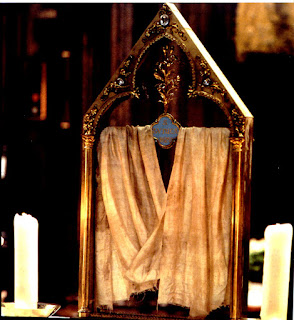So, Chartres. This location in France was a destination of pilgrimage. The shrine there housed three relics that were highly revered: the Well of the Strong Saints, the Sancta Camisia, and the head of Anna, the mother of Mary.
- The Well of the Strong Saints: the place where it is believed the bodies of early Christian martyrs were dumped
- The Sancta Camisia: the tunic Mary supposedly wore when she gave birth to Jesus. Legend states (but is more than likely a fantastic story, yet untrue) that Charlemagne gifted this relic to Chartres.
- The head of Anna: it is alleged this head was found in Constantinople during the Fourth Crusade by Louis, Count of Blois, and grandson to Louis XII. It is unclear where this relic is now, but it made Chartres a destination of a Marian pilgrimage, emphasizing the adoration the Virgin Mary and her mother, Anna. As the cathedral was built, many facets of the the artistry in the stained glass and sculpture were dedicated to the two women. The veneration of Mary and Anna are seen throughout France and is generally noted with the terms Notre Dame in conjunction with the cathedral name. Here, it is Notre Dame de Chartres. The Notre Dame that we are most familiar with (as in The Hunchback of Notre Dame) is Notre Dame de Paris, indicating it housed Marian relics and its location. It has a long and varied history, and now it houses Passion (the time period from the triumphal entry of Jesus into Jerusalem to his crucifixion) reliquary from a nearby chapel that we touch on later. This is a a sculpture of Anna, holding baby Mary, and it's located on the north porch of Chartres.
To view the cathedral and its location, click here for Rick Steve's walk through.
Engineering the Gothic Cathedral is truly a wonder and defies many ideas of what we have concerning the other name for this period: The Dark Ages. I've mentioned before the medieval need for order and their overwhelming interest in ancient Greece and Rome. Using the geometry of the ancient Greeks, the architects of the Gothic were able push the vertical limits of building. National Geographic explains here. Additional information on the concept of Sacred Geometry can be found here.
The cathedral at Chartres was early in the Gothic standard. The flying buttresses, specifically, are much sturdier and heavier in appearance, and not the finer, more elegant versions we see later on. The importance of the flying buttresses and how they allowed the ceiling to rise can be seen here. They replaced the heavy, load-bearing walls. For more information than most people would normally desire, here's a full 18 minutes of a walk through, which I broke up for my 6th-8th graders out of a sense of self preservation.
We will continue with French Gothic this week with Amiens Cathedral and St. Chappelle.



No comments:
Post a Comment